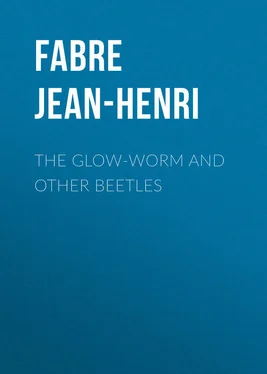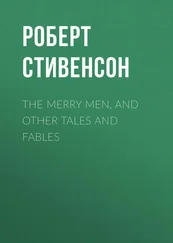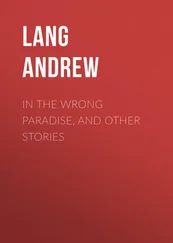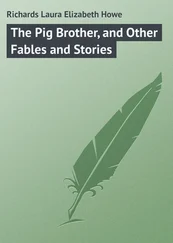Jean-Henri Fabre - The Glow-Worm and Other Beetles
Здесь есть возможность читать онлайн «Jean-Henri Fabre - The Glow-Worm and Other Beetles» — ознакомительный отрывок электронной книги совершенно бесплатно, а после прочтения отрывка купить полную версию. В некоторых случаях можно слушать аудио, скачать через торрент в формате fb2 и присутствует краткое содержание. Жанр: foreign_antique, foreign_prose, на английском языке. Описание произведения, (предисловие) а так же отзывы посетителей доступны на портале библиотеки ЛибКат.
- Название:The Glow-Worm and Other Beetles
- Автор:
- Жанр:
- Год:неизвестен
- ISBN:нет данных
- Рейтинг книги:5 / 5. Голосов: 1
-
Избранное:Добавить в избранное
- Отзывы:
-
Ваша оценка:
- 100
- 1
- 2
- 3
- 4
- 5
The Glow-Worm and Other Beetles: краткое содержание, описание и аннотация
Предлагаем к чтению аннотацию, описание, краткое содержание или предисловие (зависит от того, что написал сам автор книги «The Glow-Worm and Other Beetles»). Если вы не нашли необходимую информацию о книге — напишите в комментариях, мы постараемся отыскать её.
The Glow-Worm and Other Beetles — читать онлайн ознакомительный отрывок
Ниже представлен текст книги, разбитый по страницам. Система сохранения места последней прочитанной страницы, позволяет с удобством читать онлайн бесплатно книгу «The Glow-Worm and Other Beetles», без необходимости каждый раз заново искать на чём Вы остановились. Поставьте закладку, и сможете в любой момент перейти на страницу, на которой закончили чтение.
Интервал:
Закладка:
Jean-Henri Fabre
The Glow-Worm and Other Beetles
TRANSLATOR'S NOTE
This is the second volume on Beetles in the complete English edition of Henri Fabre's entomological works. The first is entitled The Sacred Beetle and Others; the second and the third will be known as The Life of the Weevil and More Beetles respectively.
The Glow-worm , which gives its name to the present book, did not form part of the Souvenirs entomologiques as originally published. It is one of two essays written specially, at my request, for translation into English, towards the close of Henri Fabre's life; in fact, this and The Ant-lion , a short essay for children, were the last works that came from the veteran author's pen. The Glow-worm appeared first in the Century Magazine . Of the remaining chapters, several have appeared in various periodicals, notably the English Review and in Land and Water , the editor and proprietors of which admirable weekly have shown the most enlightened interest in Fabre's work.
A part of the chapter entitled The Dung-beetles of the Pampas figures in Messrs. Adam & Charles Black's volume, The Life and Love of the Insect (New York: the Macmillan Co.), translated by myself; and the chapters on the Capricorn and Burying-beetles will be found in Mr. T. Fisher Unwin's volume, The Wonders of Instinct (New York: the Century Co.), translated by myself and Mr. Bernard Miall, which also contains The Glow-worm . These chapters are included in the present edition by consent of and arrangement with the publishers named.
Lastly, Mr. Bernard Miall has earned my gratitude by the valuable assistance which he has given me in preparing the translation of the greater part of this volume.
ALEXANDER TEIXEIRA DE MATTOS.CHELSEA, 5 September, 1919.
CHAPTER I
THE GLOW-WORM
Few insects in our climes vie in popular fame with the Glow-worm, that curious little animal which, to celebrate the little joys of life, kindles a beacon at its tail-end. Who does not know it, at least by name? Who has not seen it roam amid the grass, like a spark fallen from the moon at its full? The Greeks of old called it [Greek: lampouris], meaning, the bright-tailed. Science employs the same term: it calls the lantern-bearer, Lampyris noctiluca , LIN. In this case, the common name is inferior to the scientific phrase, which, when translated, becomes both expressive and accurate.
In fact, we might easily cavil at the word "worm." The Lampyris is not a worm at all, not even in general appearance. He has six short legs, which he well knows how to use; he is a gad-about, a trot-about. In the adult state, the male is correctly garbed in wing-cases, like the true Beetle that he is. The female is an ill-favoured thing who knows naught of the delights of flying: all her life long, she retains the larval shape, which, for the rest, is similar to that of the male, who himself is imperfect so long as he has not achieved the maturity that comes with pairing-time. Even in this initial stage, the word "worm" is out of place. We French have the expression "Naked as a worm," to point to the lack of any defensive covering. Now the Lampyris is clothed, that is to say, he wears an epidermis of some consistency; moreover, he is rather richly coloured: his body is dark brown all over, set off with pale pink on the thorax, especially on the lower surface. Finally, each segment is decked at the hinder edge with two spots of a fairly bright red. A costume like this was never worn by a worm.
Let us leave this ill-chosen denomination and ask ourselves what the Lampyris feeds upon. That master of the art of gastronomy, Brillat-Savarin, 1 1 Anthelme Brillat-Savarin (1755-1826), author of La Psychologie du goût . — Translator's Note .
said:
"Show me what you eat and I will tell you what you are."
A similar question should be addressed, by way of a preliminary, to every insect whose habits we propose to study, for, from the least to the greatest in the zoological progression, the stomach sways the world; the data supplied by food are the chief of all the documents of life. Well, in spite of his innocent appearance, the Lampyris is an eater of flesh, a hunter of game; and he follows his calling with rare villainy. His regular prey is the Snail.
This detail has long been known to entomologists. What is not so well-known, what is not known at all yet, to judge by what I have read, is the curious method of attack, of which I have seen no other instance anywhere.
Before he begins to feast, the Glow-worm administers an anæsthetic: he chloroforms his victim, rivalling in the process the wonders of our modern surgery, which renders the patient insensible before operating on him. The usual game is a small Snail hardly the size of a cherry, such as, for instance, Helix variabilis , DRAP., who, in the hot weather, collects in clusters on the stiff stubble and on other long, dry stalks, by the roadside, and there remains motionless, in profound meditation, throughout the scorching summer days. It is in some such resting-place as this that I have often been privileged to light upon the Lampyris banqueting on the prey which he had just paralyzed on its shaky support by his surgical artifices.
But he is familiar with other preserves. He frequents the edges of the irrigating-ditches, with their cool soil, their varied vegetation, a favourite haunt of the mollusc. Here, he treats the game on the ground; and, under these conditions, it is easy for me to rear him at home and to follow the operator's performance down to the smallest detail.
I will try to make the reader a witness of the strange sight. I place a little grass in a wide glass jar. In this I install a few Glow-worms and a provision of Snails of a suitable size, neither too large nor too small, chiefly Helix variabilis . We must be patient and wait. Above all, we must keep an assiduous watch, for the desired events come unexpectedly and do not last long.
Here we are at last. The Glow-worm for a moment investigates the prey, which, according to its habit, is wholly withdrawn in the shell, except the edge of the mantle, which projects slightly. Then the hunter's weapon is drawn, a very simple weapon, but one that cannot be plainly perceived without the aid of a lens. It consists of two mandibles bent back powerfully into a hook, very sharp and as thin as a hair. The microscope reveals the presence of a slender groove running throughout the length. And that is all.
The insect repeatedly taps the Snail's mantle with its instrument. It all happens with such gentleness as to suggest kisses rather than bites. As children, teasing one another, we used to talk of "tweaksies" to express a slight squeeze of the finger-tips, something more like a tickling than a serious pinch. Let us use that word. In conversing with animals, language loses nothing by remaining juvenile. It is the right way for the simple to understand one another.
The Lampyris doles out his tweaks. He distributes them methodically, without hurrying, and takes a brief rest after each of them, as though he wished to ascertain the effect produced. Their number is not great: half-a-dozen, at most, to subdue the prey and deprive it of all power of movement. That other pinches are administered later, at the time of eating, seems very likely, but I cannot say anything for certain, because the sequel escapes me. The first few, however – there are never many – are enough to impart inertia and loss of all feeling to the mollusc, thanks to the prompt, I might almost say, lightning methods of the Lampyris, who, beyond a doubt, instils some poison or other by means of his grooved hooks.
Читать дальшеИнтервал:
Закладка:
Похожие книги на «The Glow-Worm and Other Beetles»
Представляем Вашему вниманию похожие книги на «The Glow-Worm and Other Beetles» списком для выбора. Мы отобрали схожую по названию и смыслу литературу в надежде предоставить читателям больше вариантов отыскать новые, интересные, ещё непрочитанные произведения.
Обсуждение, отзывы о книге «The Glow-Worm and Other Beetles» и просто собственные мнения читателей. Оставьте ваши комментарии, напишите, что Вы думаете о произведении, его смысле или главных героях. Укажите что конкретно понравилось, а что нет, и почему Вы так считаете.












